DACF Home → Bureaus & Programs → Maine Forest Service → Forest Health & Monitoring → Invasive Threats to Maine's Forests and Tree → Browntail Moth Euproctis chrysorrhoea
Browntail Moth - Euproctis chrysorrhoea (L.)

On this Page:
- FAQs
- News & Events
- Browntail Moth Mitigation Fund
- General Information
- Management Techniques
- Where is Browntail Moth?
- For Towns & Businesses
- Research
Frequently Asked Questions
Partners at Maine Forest Service, Maine Board of Pesticides Control, Maine Center for Disease Control, Cooperative Extension and others have put together an extensive list of frequently asked questions. Questions cover topics from biology, to management, to policy to pets.
When will the caterpillars be active? +
- The caterpillars are active at two times of the year. In mid-April, they emerge from their winter webs and begin feeding and growing until they reach their maximum size in June.
- The second batch of caterpillars hatch from their eggs in August and are active until early October when they enter their winter webs to hibernate, emerging the following spring.
Close -
How do I avoid exposure to the browntail moth toxic hairs? +
- When working in heavily infested areas, wear proper protective equipment to reduce exposure including:
- Long sleeves
- Long pants
- Goggles
- Dust mask/respirator
- Hat
- Disposable coveralls
- Avoid heavily infested areas between April and August, don't use leaf blowers or lawnmowers on dry days in these areas
- Using pre-contact poison ivy wipes can help minimize hairs sticking into exposed skin
- Do yardwork on wet days, which decreases the likelihood that the hairs will become airborne.
- Make sure to use a HEPA filter on a wet/dry vacuum to decrease the likelihood that the hairs will become airborne.
- Do not dry laundry outside in infested areas.
Close -
What time of year should I clip overwintering webs? +
- The Maine Forest Service recommends clipping webs between October and mid-April before caterpillars emerge from winter webs and begin feeding on new leaves.
- This task is more easily accomplished after the leaves have fallen from the trees as the webs are more visible.
Close -
How do I determine if I have a high browntail moth population and what should I do? +
- Conduct a population assessment to determine how many webs are in the trees on your property. This should happen as early as possible in the dormant season beginning in October; however, it is often difficult to spot webs in oaks until December. A guide to surveying for webs is available online here www.maine.gov/dacf/mfs/forest_health/documents/browntail_moth_citizen_science_survey.pdf
- Contractors (licensed pesticide applicators or arborists) should be lined up as soon as a decision is made to contract for help.
- Web clipping should happen during the dormant season, generally October through Mid-April
- Caterpillar treatments should happen in early spring, generally before the end of May.
- The best time to manage browntail moth is when its populations are low.
Close -
All Frequently Asked Questions

News
Browntail Moth: What can I expect in 2026?
Browntail moth populations have been declining... but will this trend continue in 2026?
Browntail moth populations have been declining statewide since 2024. During aerial surveys this year, 4,935 acres of damage from browntail moth were documented primarily in Cumberland, Androscoggin, Kennebec, and Penobscot Counties. This is a slight increase in damage compared to 2,119 acres of damage that was documented last year.
Many insect species in Maine undergo population changes, where populations grow until they collapse, and then begin to grow again. Although we have documented a significant decrease in browntail moth populations, they will not remain low forever. The browntail moth will always be present to some extent in Maine's forests, and we expect the populations to increase again.
In late summer 2025, there were periods of extreme drought statewide. It is unclear how these drought conditions may have affected browntail moth caterpillars. Drought conditions can favor browntail moth population increases as the dry weather negatively affects the pathogens that can impact the population. However, other factors may contribute to continued lower populations.

How can I monitor browntail moth populations on my property?
Even though browntail populations remain low, scouting trees for their winter webs is the most important step in understanding possible impacts in your backyard. Because browntail caterpillars overwinter inside their winter webs on their host trees, it's important to look for and remove the webs before the caterpillars emerge in spring.
Here's how to scout for winter webs:
- On a sunny day, check for clumps of leaves at the tips of browntail moth's host trees: oak, birch, cherry, crabapple, and sometimes other fruit and hardwood trees.
- Browntail winter webs are typically 2-5 inches long and have a distinct white silk covering that protects them from the harsh Maine winters - this white silk is easier to see on a sunny day.
- Count (or estimate, if heavily infested) the browntail winter webs in each tree.

In heavily infested trees (trees with 100+ winter webs), like the ones in the photo below, winter web removal may not be appropriate. Instead, pesticide applications may be considered if these trees are in a high-traffic areas such as your dooryard or the front of your business building. For more information on pesticide applicators, please refer to the following section: "Where can I find resources for an arborist or pesticide applicator?"

How can I tell the difference between browntail winter webs and other species' webs?
In 2025, fall webworm (Hyphantria cunea) had a banner year and their webs were broadly mistaken for browntail moth webs in late summer. Fall webworm is a native insect in Maine and they do not have toxic hairs (unlike browntail moth) and their webs are typically only an aesthetic concern.
Fall webworm do not use their webs in the winter season and these structures will naturally deteriorate as time continues. There are a few ways to tell the difference between these webs:
Browntail Moth Winter Webs
- White silk present around web and attaching web to branch
Fall Webworm Winter Webs
- Matte white silk present
- Small clump of leaves, 2-5 inches long
- Large, nest-like bundle of leaves and debris, 3-15 inches long
- Tightly compacted web
- Loose, deteriorating web. May break open and fall to ground during winter from lack of use

Still unsure about scouting for browntail winter webs in your trees?
- Read a detailed fact sheet explaining the difference between browntail webs, eastern tent caterpillar webs, and fall webworm webs.
- Email us at foresthealth@maine.gov with photos of your trees with suspected browntail winter webs and we can help identify the webs on your trees for you.
- Watch our browntail moth web scouting & removal video for a step-by-step guide:
The best way to remove browntail winter webs from trees:
You found browntail winter webs in your trees, now what? Remove them!
- Remove webs that you can safely reach from the ground with an extendable pole pruner or pruning shears.
- Be sure to wear protective clothing (long sleeves, gloves, eye protection, etc.) when removing webs to prevent a rash from the residual caterpillar hairs.
- For webs that are inaccessible, or hazardous to remove (e.g. requires climbing or near power lines/traffic), consider hiring a professional to remove the webs.
- Collect clipped webs from the ground into a bucket.
- Browntail caterpillars are alive inside the winter webs. Leaving clipped webs on the ground will not eliminate the caterpillars and they will still emerge in the spring.
- Destroy the collected winter webs:
- Fill the bucket of winter webs with soapy water and let it soak for a few days to kill the caterpillars inside, OR
- Burn the webs by carefully placing the webs into a contained fire.

I can't clip all the browntail winter webs in my trees. Where can I find resources for an arborist or pesticide applicator?
Browntail mitigation should be focused on high-traffic areas for the most impactful relief. If there are populations you want to manage, hiring a licensed professional may be helpful.
If you can't remove the browntail winter webs on your property, consider hiring a professional to assist with removal. Winter web removals should be completed before the end of March. Read our list of licensed arborists and FAA-certified drone operators who perform winter web removal throughout the state.
Licensed pesticide applicators may have a limited schedule for timely spring pesticide treatments to reduce impacts from browntail caterpillars. If you have browntail winter webs in your trees that cannot be removed, consider hiring a licensed pesticide applicator and get in contact with them in early winter. Pesticide applications should take effect before the end of May to be effective. Check out our list of applicators willing to treat browntail moth.
Upcoming Winter Web Survey 2026
To understand where browntail moth populations are, we conduct winter web surveys during the winter season. We estimate total number of webs in trees alongside major roads in areas across the state. This information allows us to estimate areas that may experience impacts from elevated browntail moth populations.
These surveys are usually completed in March. After the winter web data is reviewed, it will be available on our interactive browntail moth map, which can help give you a rough idea about what browntail is doing in your community. Currently, the 2025 winter web map is available on our website:
Sign up for our Conditions Report to stay up to date on other insect and disease topics!
More Browntail Moth News Updates +
Close -
Events
- No events currently scheduled.
General Information
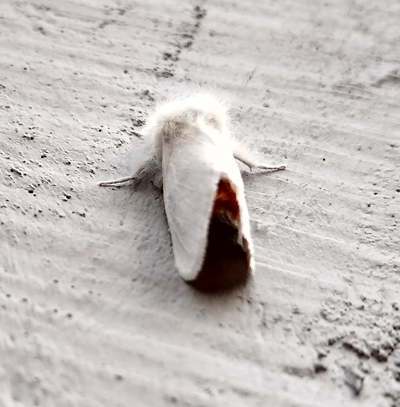 The browntail moth is an insect of forest and human health concern which was accidently introduced into Somerville, Massachusetts from Europe in 1897. By 1913, the insect had spread to all of the New England states and New Brunswick and Nova Scotia. Since that time, populations of this pest slowly decreased due to natural controls until the 1960's, when browntail moth was limited to Cape Cod and a few islands off the Maine coast in Casco Bay. Browntail moth populations are again building in Maine and are found in patches along the coast and up to 60 miles inland from the western Maine border to the New Brunswick border, with the greatest concentrations in mid-coastal Maine and the capital region.
The browntail moth is an insect of forest and human health concern which was accidently introduced into Somerville, Massachusetts from Europe in 1897. By 1913, the insect had spread to all of the New England states and New Brunswick and Nova Scotia. Since that time, populations of this pest slowly decreased due to natural controls until the 1960's, when browntail moth was limited to Cape Cod and a few islands off the Maine coast in Casco Bay. Browntail moth populations are again building in Maine and are found in patches along the coast and up to 60 miles inland from the western Maine border to the New Brunswick border, with the greatest concentrations in mid-coastal Maine and the capital region.
The larval stage (caterpillar) of this insect feeds on the foliage of hardwood trees and shrubs including: oak, shadbush, apple, cherry, beach plum, and rugosa rose. Larval feeding causes reduction of growth and occasional mortality of valued trees and shrubs. Learn More: How to Identify Maine’s Main Defoliating Caterpillars (YouTube) / Life Cycle of Browntail Moth (PDF)
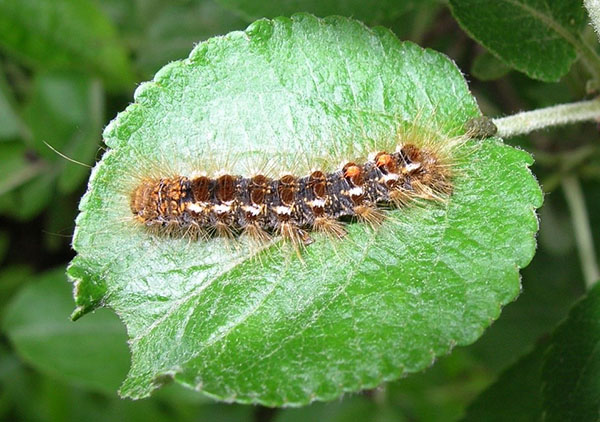
While feeding damage may cause some concern, the primary impact on humans by browntail moth results from contact with poisonous hairs produced by the caterpillars. Microscopic, toxic hairs break off the caterpillars and can be airborne or settled on surfaces in browntail moth infested areas. Sensitive individuals who encounter the hairs may develop a skin rash similar to poison ivy and/or trouble breathing. Symptoms can last anywhere from a few hours to several weeks and can be severe in some individuals. Learn More: Maine CDC Browntail Moth Information
Management Techniques
Focus management on populations that will directly impact people, pets and livestock or pose a high risk of contributing to spread.
For Smaller Trees & Shrubs +
Browntail web removal: Webs in small trees and shrubs, safely within reach of the ground, and without hazards such as powerlines, can be removed between October and March. Browntail caterpillars emerge from their webs and begin feeding in mid-April, therefore webs removed after this time will not contain caterpillars and not be effective. Destroy webs once removed (burn, soak for an extended period in soapy water, or dispose of in trash). With permission, you can do this on properties you don’t own or manage. If there are hazards, or you need to leave the ground, this is work for a licensed arborist.
Use extreme caution if burning webs. Never burn unless the branches have been clipped off. This type of burning requires a burn permit. For more information, please visit www.maineburnpermit.com and check the daily forest fire danger report.
Browntail caterpillar treatment: Pesticide applications are most effective for browntail caterpillars when the pesticide product can take effect before late May. Treatments after that time are not recommended and are not part of an effective integrated approach to management (or IPM strategy). Since caterpillars are already wandering to new locations, targeted applications are not possible. Further, pesticide applications at this time of year are more likely to impact other living species in your trees, including pollinators and native insects, without effectively reducing the impacts from browntail. At this time, there are many shed caterpillar skins and toxic hairs that have already built up in the environment. To have more effective control of browntail, plan to target the next generation of caterpillars by scouting out new winter webs this winter to determine which trees you may want to treat next spring
Applications must be consistent with the label directions. Consider hiring a licensed pesticide applicator. In most years, treatment should be effective (caterpillars killed) before late May. Later treatments do little to reduce both hairs in the environment and damage to hosts.
If you are managing browntail moth using pesticides within 250 feet of the mean high tide mark adjacent to coastal waters and extending upriver or upstream to the first bridge, additional rules apply.
If you are unlicensed, do not use this approach on properties that are not yours or are open to the public.
Close -
For Webs in Taller Trees +
Hire professional help to treat webs out of reach or near hazards on the property you own or manage. Line up help during fall or winter.
Licensed Professional Arborists can remove BTM webs in larger trees and shrubs (October to March).
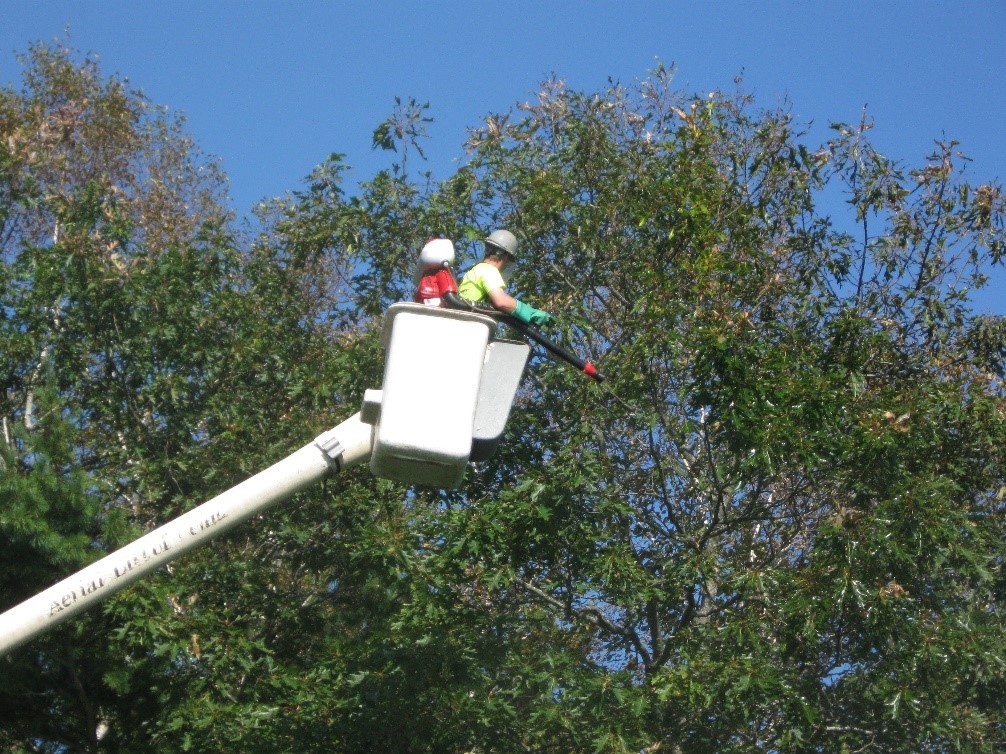
Unmanned Aerial Vehicle (UAV) Operators with an FAA Remote Pilot License may provide services using UAVs with attachments that physically remove webs.There is no requirement that these operators have knowledge of tree care. As in working with any professional, confirm your prospective contractor is adequately insured and qualified to provide the service.
- Licensed Pesticide Applicators willing to treat Browntail Moth, Hemlock Woolly adelgid and/or Other Pests
- Licensed Drone Operators (PDF)
- Arborists willing to PRUNE browntail webs in the winter (PDF)
For large trees, there are very limited insecticidal products (PDF) that are readily available to and applied by unlicensed individuals and that can legally be applied to target trees and life stages of browntail moth.** In trees where the caterpillars' hairs cause a nuisance and where it is not practical to remove the webs, Licensed Pesticide Applicators may be able to use insecticides during the growing season to manage BTM.
**Acecaps are not registered for use in Maine because the label does not meet federal standards for pesticide labeling. It is therefore not legal to use Acecaps. The Maine Board of Pesticides Control has provided support to the manufacturer to explain what needs to be changed to come into compliance and encouraged the manufacturer to work with EPA to bring their label up to standards. If we become aware of a change in status, we will update this message. You can check the current registration status by entering the product name in this database.**
Close -
Where is Browntail Moth in Maine?
Maine Forest Service conducts surveys for browntail moth from small planes and from moving trucks. These are broad-scale surveys that do not completely cover the impacted area. You can get a broad idea of where browntail moth is in Maine from our interactive map, just updated with 2025 winter web surveys. To understand what browntail moth is up to in a specific area, take a look at host plants for webs and signs of caterpillar activity.
Browntail Moth Interactive Map
Citizen Science Survey Protocol
Aerial Detection Survey Maps +
- 2025 Browntail Moth Aerial Detection Survey (PDF)
- 2024 Browntail Moth Aerial Detection Survey (PDF)
- 2023 Browntail Moth Aerial Detection Survey (PDF)
- 2022 Browntail Moth Aerial Detection Survey (PDF)
- 2021 Browntail Moth Damage Survey (with 2020-2021 Winter Web Survey data) (PDF)
- 2020 Browntail Moth Aerial Detection Survey (PDF)
- 2019 Browntail Moth Aerial Detection Survey (PDF)
Close -
Winter Web Survey Maps +
- 2023 Browntail Moth Winter Web Moth Survey (PDF)
- 2022 Browntail Moth Winter Web Moth Survey (PDF)
- 2021 Browntail Moth Winter Web Moth Survey (PDF)
- 2020 Browntail Moth Winter Web Moth Survey (PDF)
- Maine Browntail Moth Roadside Population Assessment: Winter 2018 (PDF)
Close -
For Towns and Organizations
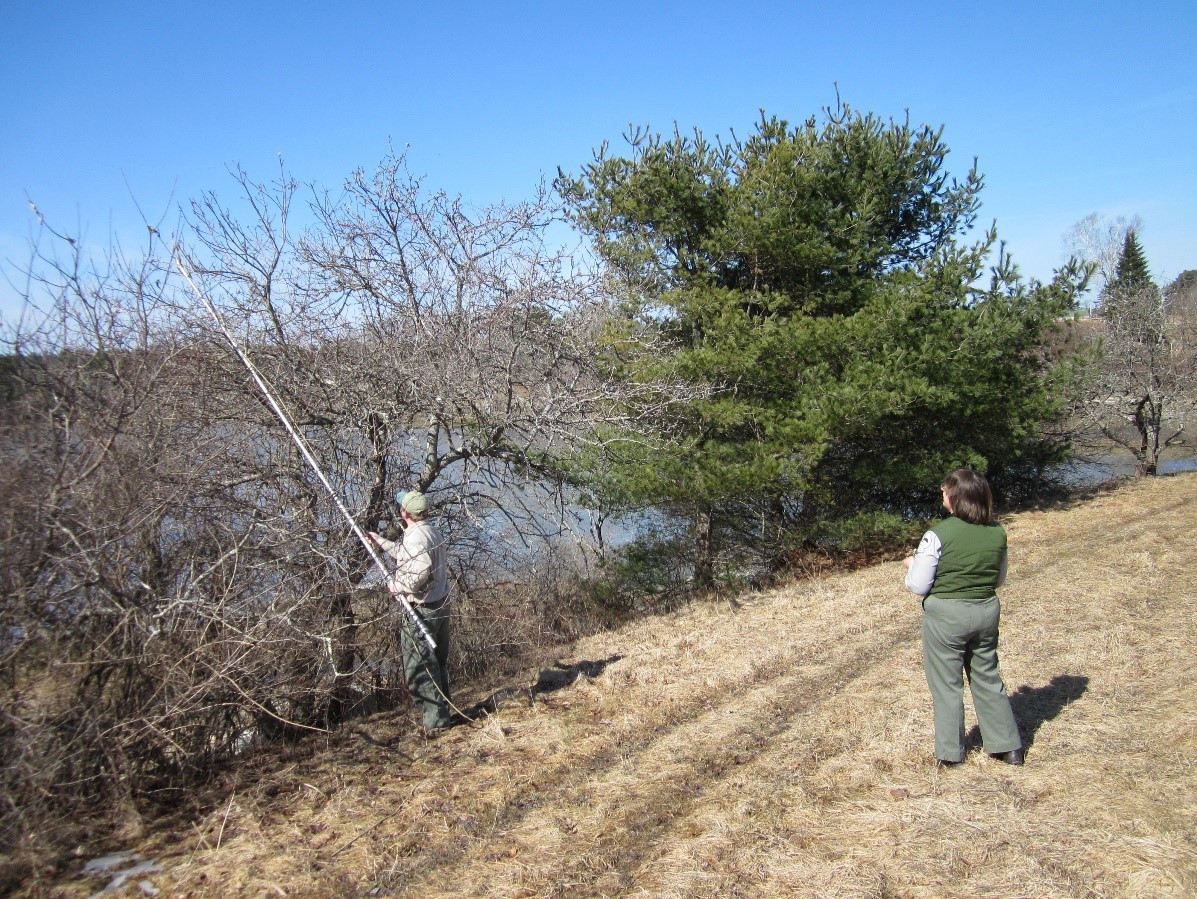
Focus management on populations that will directly impact people, pets and livestock or pose a high risk of contributing to spread.
- Management Overview for Towns and Organizations (‘Municipal Battle Book’)
- Frequently Asked Questions
- An interactive map with the latest updated survey data
- Browntail Moth Videos
Hire professional help to treat webs out of reach or near hazards on the property you own or manage. Line up help during fall or winter.
- Licensed Pesticide Applicators willing to treat Browntail Moth, Hemlock Woolly adelgid and/or Other Pests
- Arborists willing to PRUNE browntail webs in the winter (PDF | 340MB)
Social Media Toolkit +
#KnockOutBrowntail Business Challenge +
Research
Entomologists with the Maine Forest Service in the Department of Agriculture, Conservation and Forestry (DACF) have teamed up with the University of Maine to track the spread and investigate the causes of the outbreak and evaluate management strategies for this daunting pest.
- 2025: Parasitoids Attacking the Browntail Moth, Euproctis chrysorrhoea (Lepidoptera: Erebidae), During a Regional Outbreak in Maine, and Factors Influencing Their Abundance
- Evaluation of Biorational Insecticides for Management of Euproctis chrysorrhoea (Lepidoptera: Erebidae) | Journal of Economic Entomology | Oxford Academic (oup.com)
- Karla Boyd, Francis Drummond,Charlene Donahue, and Eleanor Groden; 2021: Factors Influencing the Population Fluctuations of Euproctis chrysorrhoea (Lepidoptera: Erebidae) in Maine (PDF | 693 KB)
- Karla Boyd’s 2020 thesis: "The Relative Abundance and Diversity of Parasitoids of the Browntail Moth (Euproctis chrysorrhoea L.) and Factors that Influence Their Population Dynamics"
- 2020 Summary of Research at the University of Maine (PDF | 1.49 MB), 2022 Update (PDF | 722 KB)
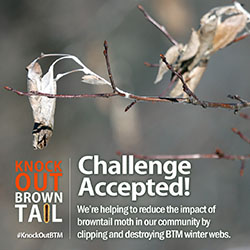
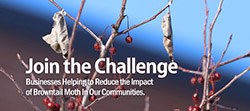
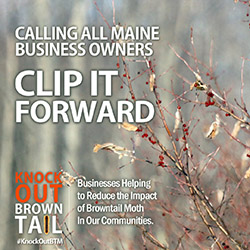
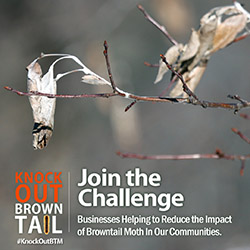
Click the images below for larger shareable graphics perfect for use on social media or Download All Graphics
Got questions about browntail moth? 211 is there to answer them.
Know your enemy and your friends. #KnockOutBTM, not silkmoths.
Image credits: DACF except promethea larva BOMONA user Zelenaks, promethea adult BOMANA user JRTindall
Learn how you can #KnockOutBTM and reduce the itch at www.maine.gov/dacf/knockoutbtm.
“browntail” in brown font
Learn how you can #KnockOutBTM and reduce the itch at www.maine.gov/dacf/knockoutbtm.
“browntail” in white font
Knock out browntail banner logo
“browntail” in brown font
Knock out browntail banner logo
“browntail” in white font
Knock out browntail stacked logo without URL
“browntail” in brown font
Facebook-ready image.
Learn how to safely remove and destroy browntail moth winter webs from the Maine Department of Agriculture, Conservation and Forestry at www.maine.gov/dacf/knockoutbtm #KnockOutBTM
To avoid encounters with the fuzzy caterpillars, remove and destroy browntail moth webs by April. Learn how from the Maine Department of Agriculture, Conservation and Forestry at www.maine.gov/dacf/knockoutbtm #KnockOutBTM
Close -